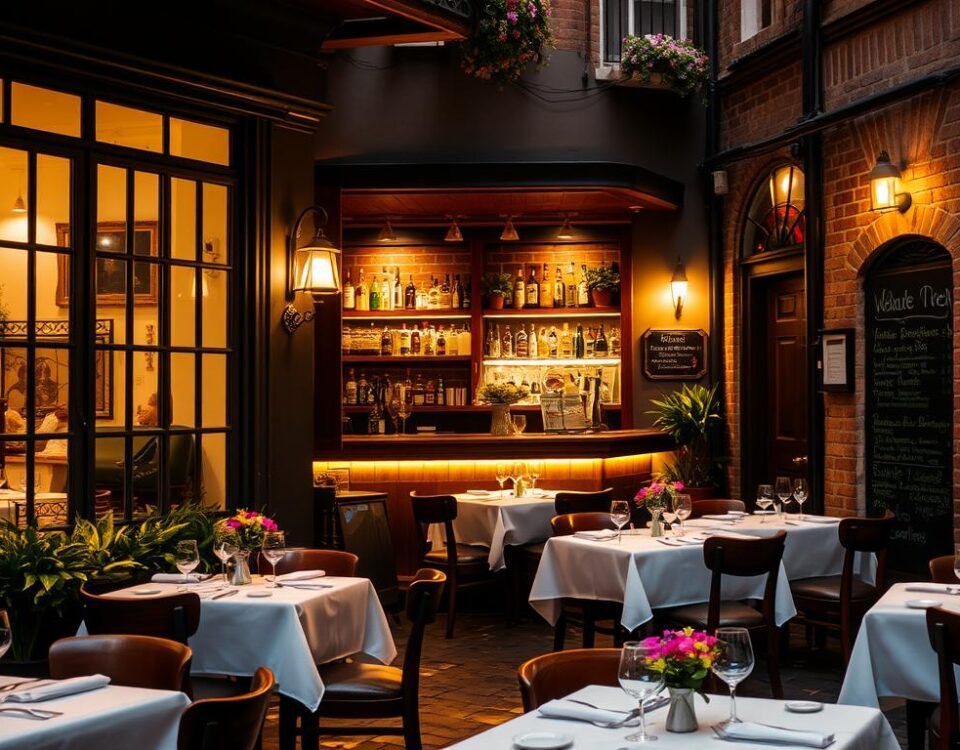
6 Fatal Mistakes First-Time Restaurant Owners Make—And How to Avoid Them
July 12, 2025
4 Common Mistakes to Avoid When Starting a Restaurant Business
July 13, 2025As I reflect on my journey to opening a successful restaurant, I’m reminded of the countless hours spent planning and preparing for the big day. It’s a daunting task, but with the right guidance, you can avoid common pitfalls and set your business up for success.
Did you know that a significant number of new restaurants fail within the first year due to poor planning? A well-structured business plan and a comprehensive checklist can be the difference between success and failure. By understanding the key steps involved in opening a restaurant, you can ensure a smooth launch and a successful future.
As you embark on this exciting venture, I’ll guide you through the essential steps to open a restaurant, from initial planning to your grand opening day. With a clear roadmap, you’ll be better equipped to handle the challenges of the competitive market.
Key Takeaways
- Create a comprehensive business plan to guide your restaurant’s success.
- Develop a detailed checklist to ensure a smooth launch.
- Understand the importance of planning and preparation in the restaurant industry.
- Identify key steps involved in opening a successful restaurant.
- Prepare for the challenges of the competitive market with a clear roadmap.
Why Your Restaurant Opening Checklist Is Critical to Success
A well-structured restaurant opening checklist is the key to a successful launch. Opening a restaurant involves a multitude of tasks that can be overwhelming if not managed properly. A comprehensive checklist helps in organizing these tasks into a sequential plan of action.
The Overwhelming Reality of Restaurant Startups
The restaurant industry is known for its high failure rate, with many establishments shutting down within the first year. One of the primary reasons for this is the lack of a proper planning framework. As I always say, “Failing to plan is planning to fail.” A restaurant opening checklist transforms an overwhelming mountain of tasks into an organized plan.
“The biggest risk is not taking any risk… In a world that’s changing really quickly, the only strategy that is guaranteed to fail is not taking risks.” – Mark Zuckerberg
How Proper Planning Prevents Poor Performance
Proper planning with a detailed checklist ensures that critical operational elements aren’t overlooked during the hectic pre-opening period. It helps in allocating resources efficiently, staying on budget, and opening on schedule – three factors critical to early restaurant success.
| Benefits of a Restaurant Opening Checklist | Description |
|---|---|
| Organized Task Management | Helps in managing multiple tasks simultaneously |
| Efficient Resource Allocation | Ensures resources are allocated effectively |
| Timely Opening | Helps in opening the restaurant on schedule |
By using a restaurant opening checklist, restaurateurs can significantly improve their chances of success. It’s not just about ticking off tasks; it’s about creating a living document that guides the entire opening process.
Step 1: Design and Build Your Restaurant Space
The design and construction phase is a foundational element in your restaurant’s journey to opening day. It’s a complex process that involves transforming your concept into a physical space where customers can enjoy your offerings.
Timeline: 120-180 Days Before Opening
It’s recommended to start the design and construction phase 120-180 days before your projected opening day. This timeline allows for the completion of crucial tasks without rushing, ensuring that your restaurant is ready for its grand opening.
Having your design and construction team in place even before signing your lease can save you time and facilitate a smoother process.
Essential Design and Construction Milestones
The design and construction phase involves several key milestones, including:
- Completed schematic designs that reflect your restaurant’s concept and operational needs.
- Submission of drawings for municipal approvals, ensuring compliance with local regulations.
- Hiring a project manager to oversee the construction process and keep it on track.
These milestones are critical to the successful completion of your restaurant’s physical space.
Working With Architects and Contractors
Working with architects and contractors who have experience with restaurant projects can make a significant difference. They understand the specific requirements and challenges associated with building a restaurant, from kitchen layout to dining area design.
Creating a Gantt chart with your project manager can help track construction milestones and ensure that all tasks are completed on time.
Step 2: Handle Legal Requirements and Licensing
Navigating the complex world of legal requirements and licensing is a crucial step in opening a successful restaurant. This process involves several critical components that must be addressed to ensure compliance with local, state, and federal regulations.
Securing Your Liquor License
Securing a liquor license is a vital step, and it’s essential to start the application process early, as it can take months to secure in many jurisdictions. If your restaurant plans to serve alcohol, you’ll need to apply for a liquor license.

Health Department Permits and Inspections
Health department permits and inspections are non-negotiable requirements that directly impact your ability to legally serve customers food and beverages. You must ensure that your restaurant meets all health and safety standards.
Business Licenses and Insurance Needs
Business licenses, insurance policies, and employer identification numbers must all be in place before you can legally operate your restaurant. It’s crucial to build extra time into your opening checklist for this step, as government agencies often move slower than anticipated.

To manage these legal requirements effectively, I recommend creating a separate checklist just for legal requirements, as missing even one permit can delay your opening or result in costly fines. Working with professionals who specialize in restaurant licensing can save you significant time and help navigate complex regulatory requirements.
Step 3: Develop Your Restaurant’s Brand Identity
As you prepare to open your restaurant, crafting a compelling brand identity should be at the forefront of your planning. This involves several key steps that will help establish your restaurant’s presence and attract customers.
Creating Your Vision, Mission, and Values
Your vision, mission, and values statements are the foundation of your restaurant’s brand identity. They guide business decisions and help attract like-minded customers and staff. I believe these statements shouldn’t be just marketing fluff; they should be authentic and meaningful.
Designing Your Logo and Visual Elements

A cohesive visual identity is crucial for your restaurant’s brand. I recommend working with professional designers to create a logo, color scheme, and typography that reflect your brand’s personality and values.
Establishing Your Online Presence
Establishing your online presence well before opening day is essential. I suggest securing your domain name and social media handles at least 3-4 months before opening to build anticipation and establish your brand in customers’ minds.
By developing a strong brand identity, you can create a consistent experience that communicates your restaurant’s unique value proposition and helps build customer loyalty.
Step 4: Order Equipment and Supplies
Now that you’ve designed your restaurant space, the next crucial step is ordering the equipment and supplies that will bring your vision to life. This step is critical to ensuring your restaurant operates efficiently and provides a great dining experience for your customers.
Kitchen Equipment Essentials

Your restaurant’s kitchen equipment needs to balance efficiency, durability, and budget. Essential pieces include commercial-grade ovens, stoves, refrigerators, and dishwashers. I recommend placing equipment orders at least 3-4 months before opening, especially for custom kitchen equipment that can have long lead times.
Front-of-House Furniture and Fixtures
Front-of-house furniture and fixtures directly impact your guests’ comfort and experience. This includes tables, chairs, umbrellas, and any additional millwork related pieces for your concept. Ordering these items early ensures you get the quality and quantity you need.
Technology Systems: POS, Sound, and Security

I suggest researching and selecting your point-of-sale system early, as it will integrate with many other aspects of your restaurant operations. Additionally, consider sound systems, security cameras, and other technology infrastructure that need to be ordered with enough time for proper installation and testing before opening.
Don’t forget to include smallwares (utensils, glassware, plateware) on your opening checklist, as these items are often underestimated in both quantity and cost. Bar equipment also has specific requirements that differ from kitchen equipment, so outline the essentials for setting up an efficient bar service area.
Step 5: Create a Comprehensive Restaurant Opening Checklist
Creating a restaurant opening checklist is not just about ticking boxes; it’s about laying the groundwork for a thriving business. As I guide you through this critical step, you’ll understand the importance of having a detailed plan in place.
3-4 Months Before Opening Day Tasks
At this stage, focus on major foundational tasks. This includes applying for a liquor license if required, finalizing graphic designs, and securing web and social domains. You’ll also need to order bar and kitchen equipment, furniture, and any additional millwork related pieces for your concept. Developing your vision, mission, value, and culture statements is crucial, along with preparing operational strategies and deciding on operational vendors.
| Task | Timeline | Description |
|---|---|---|
| Apply for Liquor License | 3-4 months | If required, start the application process early due to potential delays. |
| Finalize Graphic Designs | 3-4 months | Complete branding initiatives, including logo design and visual elements. |
| Secure Web and Social Domains | 3-4 months | Ensure your online presence is established with relevant domains. |
60 Days Before Opening Day Tasks
As you hit the 60-day mark, many elements start coming together. This is the time to install signage, create your menu, and onboard key management. Your restaurant opening checklist should be evolving, with tasks being checked off and new ones added as needed.
- Install signage and exterior branding elements.
- Finalize your menu and pricing strategy.
- Begin onboarding key management staff.
30 Days Before Opening Day Tasks
By this stage, your focus should be on training, systems testing, and final preparations for soft openings. Ensure that your staff is well-trained, and all systems, including POS and security, are tested and ready for launch.

Using a digital project management tool to track your opening checklist can significantly enhance your team’s efficiency and visibility into the opening process. This comprehensive timeline approach ensures you’re tackling the right tasks at the right time, preventing last-minute rushes that can derail your opening day.
Step 6: Build and Train Your Restaurant Team
A well-trained team is the backbone of any successful restaurant, making it essential to build and train your staff effectively. This involves several key steps, from hiring key management positions to recruiting and onboarding staff, and finally, to providing effective training programs.
Hiring Key Management Positions
Hiring key management positions, such as your chef and general manager, at least 60 days before opening is crucial. These individuals will help shape many aspects of your restaurant, from menu development to operational efficiency. By bringing them on board early, you can ensure that your restaurant is well-planned and ready for a successful launch.
Recruiting and Onboarding Staff
As you approach your opening date, it’s time to recruit and onboard the remainder of your team. This should be done progressively, with front-of-house and back-of-house staff being brought on closer to the opening date. Developing comprehensive job descriptions, interview questions, and onboarding materials in advance will streamline this process.
Effective Training Programs for Opening Success
Training is critical to your restaurant’s opening success. I recommend allocating at least 1-2 weeks for intensive staff training before any soft openings. Your training program should cover technical skills, as well as your restaurant’s culture, values, and service standards. Involving team members in mock service scenarios can help identify operational issues before real customers arrive.
By focusing on building and training a strong team, you can ensure that your restaurant is well-prepared for a successful opening and long-term success.
Step 7: Finalize Your Menu and Supply Chain
As the opening day of our restaurant nears, the importance of a solid menu and efficient supply chain cannot be overstated. Finalizing these elements is crucial to providing excellent service and ensuring the success of our establishment.
Menu Development and Engineering
Menu development should begin early in the opening process, but final testing and refinement should occur about 60 days before opening. Our menu isn’t just a list of food items; it’s a strategic document that needs to balance customer appeal, kitchen efficiency, and profitability. To achieve this balance, we must carefully consider our menu engineering strategies.
Key considerations for menu development include:
- Balancing customer preferences with kitchen capabilities
- Ensuring profitability through careful pricing
- Creating a visually appealing menu design
Food and Beverage Supplier Relationships
Establishing relationships with multiple food and beverage suppliers at least 2-3 months before opening is crucial to ensure reliable service when we launch. This involves researching potential suppliers, comparing prices, and assessing their ability to meet our needs consistently.
| Supplier Criteria | Importance Level | Notes |
|---|---|---|
| Reliability | High | Consistent delivery is crucial |
| Price | Medium | Competitive pricing is important |
| Quality | High | High-quality ingredients are essential |
Recipe Testing and Staff Tastings
Recipe testing is crucial to standardize preparation methods, portion sizes, and presentation. Each menu item should be prepared multiple times to ensure consistency. Staff tastings serve dual purposes: they familiarize our team with the menu items and generate valuable feedback for final adjustments.
“The best way to ensure consistency in your restaurant is through thorough recipe testing and staff training.”
To facilitate this process, I suggest creating detailed recipe cards with photos for both kitchen and bar staff. This will ensure consistency in preparation and presentation. Our restaurant opening checklist should include organizing all food and beverage orders for training sessions, soft openings, and our official opening day.
Conclusion: Your Restaurant Opening Day and Beyond
After navigating through the essential steps to opening a restaurant, you’re now poised to take the leap and open your doors to the public. With thorough preparation, your restaurant is set for a successful launch.
As you prepare for opening day, ensure your venue is impeccably clean, both inside and out, with no signs of construction. A well-executed soft opening will have prepared your team for the first customers, boosting their confidence.
Key to your restaurant’s success is not just the opening day but the days that follow. Creating daily checklists will help maintain the high standards you’ve established. Remember, the restaurant business is constantly evolving, so your checklists should be living documents, refined based on experience.
Your restaurant opening checklist has prepared you for success, but flexibility and adaptation will be crucial for long-term business growth. By maintaining a focus on customer service and continually assessing your operations, you’ll be well on your way to establishing a thriving restaurant.
FAQ
What are the most critical elements to include in my restaurant’s operations system?
Your operations system should include a comprehensive plan for managing staff, kitchen, and service. This encompasses staff training, inventory management, and customer service standards to ensure a smooth and successful launch.
How do I ensure my staff is adequately trained for the service on my restaurant’s first day?
To ensure your staff is well-prepared, develop a thorough training program that covers menu knowledge, customer service skills, and equipment operation. Regular training sessions and practice will help build confidence and competence among your team members.
What is the best way to manage inventory and supply chain for my restaurant’s menu?
Effective inventory management involves establishing relationships with reliable suppliers, implementing a robust inventory tracking system, and regularly reviewing menu item sales to adjust orders accordingly. This helps minimize waste and ensure that you have the necessary ingredients and supplies to deliver high-quality dishes.
How can I create an effective customer service strategy for my restaurant?
To develop a successful customer service strategy, focus on creating a positive dining experience by training staff to be attentive, friendly, and responsive to customer needs. Implementing a feedback system can also help identify areas for improvement and enhance overall customer satisfaction.
What safety and security measures should I have in place for my restaurant?
To ensure a safe and secure environment, implement measures such as CCTV cameras, secure cash handling procedures, and emergency response plans. Regularly review and update your safety protocols to address any potential risks or concerns.
How do I handle daily specials and menu changes effectively?
To manage daily specials and menu changes, establish a clear communication plan to inform staff and customers of updates. Utilize social media, email newsletters, and in-house promotions to showcase new offerings and drive sales.
What is the importance of cleanliness and maintenance in my restaurant?
Maintaining a clean and well-maintained restaurant is crucial for customer satisfaction, health and safety, and overall reputation. Regular cleaning schedules, equipment maintenance, and inspections can help prevent issues and ensure a positive dining experience.



